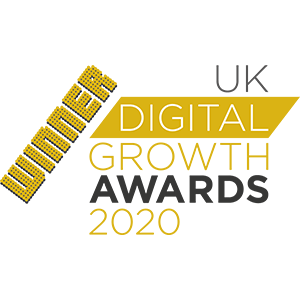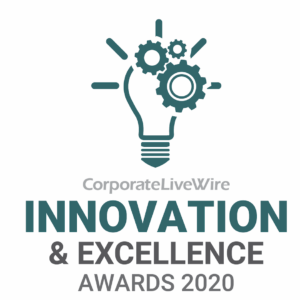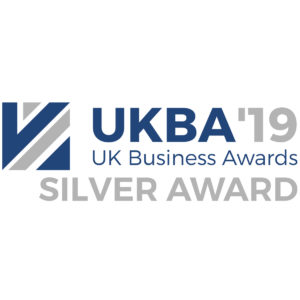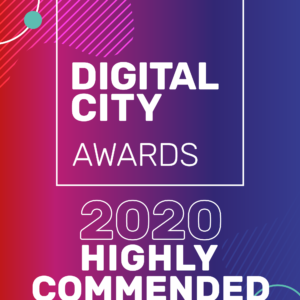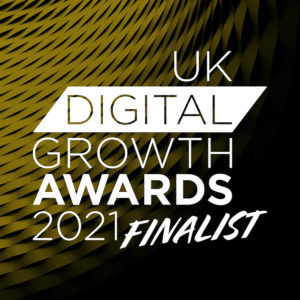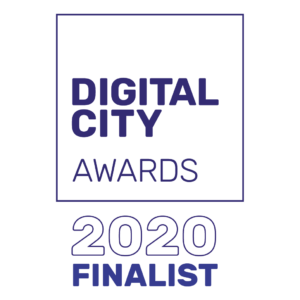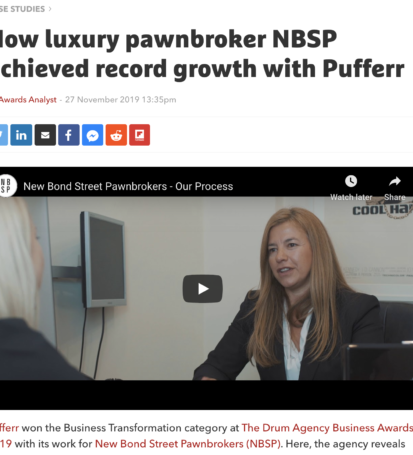The marketing industry is evolving at breakneck speed, with new and emerging technologies creating new ways for customers to interact with brands, and vice versa. Many consumers may not even be aware of many of the changes as they are happening, but the impact is experienced every single day.
We do not like to brag about our clients and successes (the awards we won speak louder than words). However, we recognize that sometimes seeing how everything comes together speaks louder than words, which is why we’ve put together a case study that is universally applicable to most businesses around, whether an e-commerce store, SME, presentation website, healthcare company, travel website and so forth. We chose a traditional high-end pawnbroker as the object of the study, because it underlines most challenges we have been discussing within this post: the business was running increasingly expensive and inefficient Google ads for years, without experimentation of any other channels or technologies; its market share was also decreasing at a fast pace. Moreover, the long-term serving digital marketing agency they partnered with continued to limit its services to several traditional channels, mainly due to the lack of demand from its low budget customer base.
New Bond Street Pawnbrokers (NBSP) was founded in 1999 by David Sonnenthal. David was first introduced to the pawnbroking industry by his father, who was also operating a pawnbroking business for decades. NBSP provides loans to a high-end clientele using luxury collateral items like classic cars, diamonds or rare books.
Ever since its formation, NBSP has been relying on its premier location within Bond Street, Mayfair to attract a variety of high-end clientele that resided in the area, who chose the convenience of pawning a luxury asset to a bank loan. Over the years NBSP saw their business eroded by intense competition, changes in customer behavior (online), the rise of digital marketing and shifting demographics within the area, with many customers moving out of London. In 2018 David reconsidered NBSP’s approach to doing business, parted ways with NBSP’s long term serving digital marketing agency and employed Pufferr to achieve his vision of tackling the demographics and customer behavior challenges by becoming the best and most innovative high-end pawnbroking company online.
Read the full case study HERE
This being said, in my experience of working with quite a few family businesses & SMEs more often than not marketing teams at these companies lack the digital marketing experience or savviness to staying up to date, master or experiment with recent and emerging channels and technologies. This is generally by no way attributed to intellectual laziness, but rather to a combination of factors including competing challenges within the business, the cultural DNA of the company i.e. focus on immediate ROI at the expense of innovation and experimentation, lack of resources i.e. budget, team members, the good old-fashioned politics, and many more.
Moreover, at many family businesses & SMEs, the function of marketing is often delegated to a non-marketing member of staff, and of course, we can immediately see how asking of them to master digital marketing is an unrealistic expectation. For these reasons, marketing teams within family businesses & SMEs turn to the digital marketing agencies they employ for advice, and rely on them to staying up to date with these fast-changing technological and advertising trends.
Unfortunately, quite often digital agencies offering digital marketing service, SEO, PPC etc to architecture companies display similar cultural characteristics: cost-cutting strategies, fewer, less experienced & lower-paid employees are allocated more accounts, no time or budget is allocated to training, to name just a few of the reasons why developing expertise in emerging technologies and channels never occurs within traditional digital marketing agencies. In fact, you will find that many agencies will often stick to channels they learned and worked well historically, which is why somehow SEO, Google, and Facebook ads represent the status quo in terms of attracting new clients.
Furthermore, digital agencies that actually take the leap and invest in emerging technologies often find that marketers within the family businesses & SMEs dismiss the promises of building the business for the future at the expense of the immediate results (for reasons already described)…they actually insist on continuing to run SEO, Google or Facebook ads exclusively under the wrong business as usual assumption.
In fact, you will not be surprised to learn that the one question that most marketers ask me at the family businesses & SMEs I worked with is: “What is the ROI of developing an Alexa application?” (or for that matter Google Home app, chatbot, etc). After all, in claiming a budget from the Finance Manager the marketer will need to answer this very question, and the finance guy always likes a good chat about the numbers. Small family businesses & SMEs businesses are understandably even more focused on ROI, after all, they operate on a low budget, and seeing results is essential to getting assurance in their choice of advertising.
Of course, any experienced marketer or leader who read the brilliant “Innovator’s Dilemma” by the equally brilliant Harvard professor Clayton Christensen, will quickly recognize the immediate ROI matter as the wrong question, and the hallmark of many great businesses failing to adapt to the fast-changing marketing world.
To conclude, even savvy digital marketing agencies are being held hostage by the immediate ROI culture developed within architecture companies (and many other types of companies), fail to attract the demand required to make up the resources invested in new channels and technologies, and revert to the status quo (SEO, Google and Facebook ads exclusively). In turn, companies within family businesses & SMEs experience higher competition, increased costs, and lower number of leads i.e. it is not unusual for cost per clicks to cost as high as £15 per click or more.
Of course, it doesn’t have to be this way…
Family businesses & SMEs can make use of new technologies in advertising and marketing to empower themselves to compete in a way that simply wasn’t possible before. Though these marketing technologies and techniques are all at your disposal, it’s important to recognize that advertising is about more than simply ‘doing SEO’ or ‘doing social media’. It is about taking a holistic approach to marketing, and building a brand that clients recognize and feel confident to work with.
The fundamental doctrine of marketing has long been the concept of the 4 Ps: Product, Price, Place, and Promotion. With the changing face of marketing tools and technologies, this model is being disrupted, and marketers within family businesses & SMEs need to take up new methods to reach their audiences. Yes, the typical client seeking your services still uses Google en masse, but an increasing amount of time is being spent on a growing list of social media platforms and communication apps, including but far from limited to:
- Slack
- Viber
- Snapchat
- Quora
In addition, voice-controlled devices like Alexa, Google Assistant, and Siri are gaining a presence in our smartphones, smart speakers, televisions, computers, tablets, and even cars. Moreover, voice searches are on the rise, gradually taking the place of traditional searches…it is highly probable that within a few years typing querries in Google will seem an ancient habit.
It is all part of a trend towards maximum convenience at every turn, and it is reflected in the fact that people don’t want to fill in contact forms anymore. In fact, clients of all businesses are more and more shifting their expectations and behaviors: they want instant answers when they visit a website, hassle-free interactions, and confidence in the company they will do business with. They are often savvier, up to date with technology and will make decisions on the culture and competence of your company, based on a variety of factors both unconscious i.e. psychological (first impression, confirmation bias, association principles. etc…for a more detailed conversation on factors influencing online behavior please see our comprehensive post here ) and experience/perceptions of what competence looks like.
In one example of a particular company I know, the digital agency used to drive a lot of expensive traffic via Google ads but had very low conversion rates….on reviewing their digital strategy one of the most striking aspects was the outdated look & feel of the website; the website was in dissonance with the high-end brand identity they were looking to project to potential high-net-worth clients. One year later and a complete re-design of the website, this company registers a 52% increase in conversion rates YOY. Most importantly its three-month trend shows an improvement of 83% in conversion rates YOY, confirming the long term success and benefits of re-aligning their brand identity.
We developed a marketing blueprint that is aimed directly at most family businesses & SMEs that are trying to leverage new technologies to grow and develop. It combines elements of traditional marketing, modified to have the flexibility to adapt with inevitable changes in the future of advertising and powerful technologies that can enable these firms to compete and leapfrog less savvy competitors. There are 3 steps to the blueprint, and we will run you through the process in this article.
Step 1: Understanding your client target base

This may sound obvious, however, you will be surprised at how often family businesses & SMEs firms pour resources exclusively in SEO and Google ads without a clear data-based strategy to map out the characteristics of their ideal clients. (BTW, you will be surprised how many companies put money in advertising just to get stuck into bad customer service, as the case study of Affix `Scaffolding London shows). There are various elements to this process:
Run a comprehensive analysis of your website traffic:

What is their age, demographics, gender, location, or education level? What pages do they visit, how often, what is the funnel, how long are they spending on your pages, where do they drop out and why?
You will most often be able to infer interests and characteristics and identify the archetypes that bring in the most business. You can achieve this with tools that help you track the performance of your website and digital channels, such as analytics, segmentation, heat maps, live behavior recordings, goals, sales funnels, split tests, custom audiences, and lookalike audiences.
Think about psychographics as well:

These are the more personal characteristics of the individuals looking for various services, including their personality, values, attitudes, interests, behaviors, and lifestyle. You need your service to be easily incorporated into their lifestyle. This will also help identify channels through which you could connect with your target audience.
Once you have developed a solid understanding of these things, you can get down to the nitty-gritty of determining the brand identity you are looking to convey. Be as specific as possible in outlining your mission, the visual style you want to present, the tone of voice of your content, the values you want to uphold, and everything else about the identity of your company. But most of all, remember that in the end, it is all about the type of business that clients want to work with..too often more consideration is being given to the type of business the founder would like to be associated with.
With the risk of repeating ourselves, this may sound obvious, but I assure you that more often than not family businesses & SMEs develop brand identity elements that are saying a great deal about the cool personality of the website developer, Marketing Director, founder, or the HIPPO. For example, one company I was brought in to look at developed an expensive brand-new website with no involvement from SEO and Paid Search teams. It did not help that the Marketing Director, who coordinated the project had no digital background either. Needless to say, within two months of the re-launch the traffic to this website halved, ending up with the Marketing Director leaving the business.
Thus, this is where more technical considerations come into play. At a basic level SEO will be a factor of getting your brand in front of individuals or companies seeking your advice. You will need an effective keyword strategy in place, and you will need to carry out comprehensive research into your competitors too.
In fact, it is absolutely essential you understand that by failing to get your keywords, brand identity, and audience right, any efforts you make on the basis of this foundation will be rendered ineffective. You will target the wrong people with the wrong intent through the wrong channels, and you won’t maximize the number of leads you could receive. Your traffic may increase, but that traffic would not translate into more business. Alternatively, you may rank your website on the first page in Google for keywords with no commercial value.
For example, another company I know was super happy with a digital marketing agency that ranked his website on the first page in Google for “architect services in XXXX” (for privacy reasons I replaced the name of the particular area in London they were ranking for i.e. architect services in Ealing, Hammersmith, etc). He asked me to work with the agency to convert better on-page, given their prominent position in Google for the area they ranked in. The problem was though, that the search term they were ranking for had no search volume at all…in brief, no one was actually searching for it.
Step 2: Choosing the right channels/tools (the ‘Place’ from the 4 Ps)
The following are some suggestions of digital technologies that family businesses & SMEs can leverage to fulfill your brand identity and target the audience you have identified in Step 1
Google Actions and Alexa Skills

One of the biggest recent changes in SEO is the rise of voice searches. Google has announced that 20% of mobile search queries happen through voice search. Siri, Alexa, and the Google Assistant have been revolutionary in the way consumers search for content, and it is likely that this approach will overtake traditional keyboard searches. Alexa’s built-in capabilities, called ‘skills’, offer in-skill purchasing wherein they can seamlessly buy something that is suggested to them whilst they interact with a skill, and sellers can create and publish in-skill products to make targeted sales.
There are also local SEO tools for Alexa and Google, and the voice assistants are integrated with their host platform’s ‘Pay’ tools to enable users to effortlessly make payments on-the-go for any products or services they want. So a lawyer could create a skill for Alexa that enables them to look up local divorce lawyers whilst offering the in-skill purchase of their own service, enabling the user to pay for a consultation with their integrated Amazon Pay tool for a streamlined, targeted acquisition and conversion of a lead.
It is not hard to conclude that seekers of your services will use Voice search more and more in the future, so it is a no-brainer that companies within this field will better get ready. Furthermore, it is not a secret that Google has already started to experiment with different ad formats on Google Assistant apps either, thus it is very likely that Google Assistant ads, and for this matter, Alexa ads as well will deliver a higher conversion rate.
Chatbots

Automated website chatbots offering help, support, and answers to questions pop up on most modern websites or social channels and apps i.e. Facebook, Twitter, Slack, Skype, Viber, Telegram, Microsoft Cortana and many, many more. These tools make it convenient and simple for inpatient and spoilt for choice individuals to get in touch from wherever they hang out online and have become the preferred option over the traditional website contact form. As an example, one family-owned pawnbroking company I worked with developed funnels based chatbots for its Facebook and Twitter accounts, a Livechat like chatbot on their website, and Alexa & Google Home apps as well.
And, since it is software, family businesses & SMEs do not need to employ a customer service team or a team of data analysts either, enabling marketing teams to get the valuable data and analytics that were once reserved to the biggest and most techie companies only.
Finally, chatbots also deliver an automated sales funnel and can be optimized for marketing. For example, on running Facebook chatbot marketing campaigns we often find that open rates are double as compared with the more traditional email marketing campaign.
Augmented Reality (AR) and Virtual Reality (VR)

Augmented and Virtual Reality technologies are being used in creative and innovative ways by businesses of all sizes to market products and services. For example, local estate agents can create a VR experience to give potential buyers a walkthrough of a property without actually visiting it in person. If you can use this type of technology to create an engaging and informative experience for your potential customers, it could really help with conversions.
Firstly we need to acknowledge that VR has not yet taken off the world by storm. And yet, this is one technology we recommend that companies providing various services developed as part of their digital strategy. Why?
Well, for a start remember that your brand identity needs sculpting around the perceptions held by many people. As more and more of these individuals are technology savvy, a VR application will only enhance your brand identity. Secondly, by getting into VR early you will both learn the potential and limitations of the technology i.e. it is not unrealistic to predict that in the future a meeting with a potential client will be more effective in VR than within Skype or Zoom environments. Furthermore, I am sure that in a near-future your customers will better experience many of your services within VR. And the examples can continue.
Finally, just as Voice ads are coming to the personal assistants and devices, VR ads have the potential of becoming yet another distribution channel for savvy and connected individuals. In fact, the most iconic brands like Coca Cola or Google are already running large VR ads campaigns to reach new audiences.
Games (2D and 3D)
 Games can actually be a very powerful tool for marketing purposes, given that there are 3.196 billion people actively engaging with social networks every single day, with an average daily usage of 2 hours and 22 minutes. This is the perfect place to get potential clients engaging with your marketing efforts, given that traditional techniques are becoming less and less effective.
Games can actually be a very powerful tool for marketing purposes, given that there are 3.196 billion people actively engaging with social networks every single day, with an average daily usage of 2 hours and 22 minutes. This is the perfect place to get potential clients engaging with your marketing efforts, given that traditional techniques are becoming less and less effective.
The truth is that your audience is being barraged with direct attempts to sell products and services to them at every turn, and they are far less likely to engage with this form of marketing. Conversely, a branded game can really get their attention and put your brand on their radar through experience, rather than a direct advertisement. This will, in turn, boost your traffic and user engagement at the top of the funnel, and develop familiarity with your brand…the results can be exciting.
Blockchain
Blockchain, the powerful technology behind cryptocurrencies, is finding its way into all sorts of industries, and marketing is no exception. It can optimize the utilization of resources to improve targeting efficiency through things like local marketing campaigns, pay-per-click (PPC) advertising and more. It can improve privacy to ensure consumers feel safe to use your platform when purchasing. It can help decentralize a number of processes to achieve more customized technologies and tools to engage with your audience.
One exciting project that an Ethereum co-founder is working on is Akasha, the first decentralized social media platform. If the project turns up to be successful, Akasha will facilitate a new, “attention-based model of social media marketing”: you, the family business or SME will eliminate the gatekeeper i.e. Facebook, Google, etc and advertise directly to the audience of interest. This would on one side maximize the use of your budget, and on the other side you will reach people who actually want to experience your ads, Of course, many hurdles must be overcome for this project to become a viable alternative to large corporations like Facebook, and yet staying tuned to the progress will give you a significant head start against your competition.
Step 3: Advertising techniques (the ‘Promotion’ element of the 4 Ps)
 After developing a comprehensive understanding of your target audience, optimizing your branding, and identifying the technologies to use for marketing, the time has come to focus on the technicalities of your marketing efforts. All the channels you will employ should be entirely driven by the work you have done so far, and marketers at family businesses & SMEs need to think about the following tools:
After developing a comprehensive understanding of your target audience, optimizing your branding, and identifying the technologies to use for marketing, the time has come to focus on the technicalities of your marketing efforts. All the channels you will employ should be entirely driven by the work you have done so far, and marketers at family businesses & SMEs need to think about the following tools:
Search Engine Optimisation (SEO)
For brick and mortar accounting companies the focus will often be on local SEO in first instance. Google is designed to offer users the most relevant results from their local area i.e. in a very simplistic way, if a user performs a search for an architecture firm from a London location, the results will be focused on London-based providers. Thus, regardless of your global focus, as a locally based business, you need to ensure your SEO work targets people searching within your locality. Once this step is fully optimized, you can turn your focus on the more global aspect of their search engine optimization efforts.
Paid search results
By targeting the right keywords and localities, PPC campaigns i.e. Google ads, Microsoft ads can still be an effective way of reaching clients seeking accounting advice. Of course, the competition is fierce and with it increased costs are a reality. However, the one advantage a well-optimized Google Search campaign has over other channels is user intent…people are actually searching for terms like “architects in London”, “hairdressers in Ealing” and so forth.
It is however extremely important that your campaigns are set up and optimized continuously to minimize the waste of budget, though in my experience most reasonably priced agencies will limit themselves to a “what you pay is what you get mindset”.
Social media advertising
Those very same social media platforms that so many consumers visit every day have their own advertising mechanisms that operate on a PPC basis. On the whole, the CPC on social media advertising is lower vs. Google Search ads and this can be harnessed using the same principles we have covered above i.e. targeting the right people with the right interests, characteristics, etc underlining once more the importance of the comprehensive research discussed at point 1.
Thus, any digital growth strategies architecture companies choose to reach potential clients will need to consider the comprehensive research undertaken at step 1. This way, you will reach the right individuals on channels and topics they actually engage with i.e. Snapchat, Pinterest, Quora, Yelp and Waze to name just a few. Far too often family businesses & SMEs are advised by their agencies to run traditional channels i.e. SEO, Google ads, Facebook ads exclusively. As previously noted, in my experience the advice often has something to do with agencies recommending channels they have learned over time vs. channels they are not comfortable with, rather than focusing on the actual client profile and potential opportunities created by new, emerging or untapped channels.
In conclusion, you can only determine the effectiveness of various channels by running campaigns, measuring results and benchmarking results vs. other channels.
Our advice is straightforward: anecdotical, non-evidence based decision making on spending your budget must be avoided…your digital marketing partner has the moral responsibility to provide robust growth plans, even when by doing so they place themselves out of their comfort zone.
Instagram influencers
Most people think about Instagram influencers as big hit personalities. The Kardashian clan is one example that comes to mind. However, it is very likely that high net worth individuals are not actually interested in the Kardashians (go figure!). Again, if you took the time to do your homework at Step 1 you will have a much better understanding of the interests and characteristics of your audience. And, you will not be surprised to find that your potential clients are human too…they do like traveling, books and all sorts of other things. And more often than not, micro-influencers may be a better bet to offering genuine, non-commercial experiences and content. It goes without saying that you could save yourself a lot of big Instagram advertising budget by ditching the Kardashians and targeting instead a larger portfolio of Instagram micro-influencers.
360 VR and AR ads
As previously stated, advertisements that deliver an experience for the user are far more engaging than traditional adverts, and nothing leverages cutting-edge technology better than AR and VR ads. Providing this type of experience makes your ad exciting and memorable. As VR and AR become more widely adopted, this is definitely one emerging channel marketers at family businesses & SMEs should keep an eye on.
In fact companies like The New York Times, CNN, Samsung, Snapchat or L’Oreal are only few of the many iconic brands already running VR and AR ads campaigns.
Programmatic display
Programmatic display was around for quite a while, though it was plagued by a multitude of challenges that have left family businesses & SMEs “on the fence” regarding its use as a channel i.e. one of the biggest challenges was brand safety, with ads often showing in inadequate places and to irrelevant audiences. These challenges mainly occurred due to the underdeveloped algorithms that matched content to the audience. Of course, algorithms have been making leaps and bounds in performance, and programmatic display is yet again a channel leveraged by most serious companies around.
The ability to reach audiences based on keywords they searched for, micro-targeted locations and a range of interests make programmatic display a must-try channel for companies offeringvarious services.
One of the Chiswick based IT company I worked with ran a Programmatic display campaign targeting the City only and saw a 24.33% increase in conversion vs. the Facebook ads campaign targeting the same area.
Native ads
This type of content is essentially marketing work that resembles a publication’s own editorial content, and it can be a very effective way of putting your products/services in front of potential customers.
By now the importance of the research you have been carrying out at Step 1 should be obvious… which publications are your ideal clients likely to read and trust, and what kind of content do they consume? Armed with this information, you can now go ahead with writing relevant content and launch your native ads campaign.
Of course, the power of association is at work here as well, and can both increase and hurt your conversion…optimise, optimize and optimize. That is, make sure that the right article is served on the right newspaper, relevant pages, correct title etc. Platforms like Outbrain allow for the removal of publishers that are irrelevant to your audience, split tests of titles, highly targeted locations and much more.
In effect, when an article is being read on Financial Times, it is more likely that the newspaper will “lend” its professional image to the author of the article. In simple terms, as the sponsored post appears on Financial Times the individual seeking your services reasons that the post and the company who wrote it are highly professional too.
The bottom line
This article lays out the blueprint for a marketing approach for family businesses & SMEs of all sorts, but it is only the framework. You will need to do the hard work to make the discoveries and observations required in Step 1, specify the technologies you will use in Step 2, and enact the highly targeted and optimized actions in Step 3.
One thing is for sure: you must embrace cutting-edge technologies in your marketing efforts to make full use of consumer behaviors and target quality traffic that has the highest chances of achieving conversions. But most importantly, remember that advertising technologies and platforms are tools and nothing more. Getting to know your prospects and analyzing your data continuously is paramount to deciding which tools, strategies, and technologies to use. In brief, start with Why, and follow with How?
Of course, if you require digital marketing services, SEO & PPC services for your family business or SME in London or throughout UK, do get in touch…we do not bite (I promise…).







